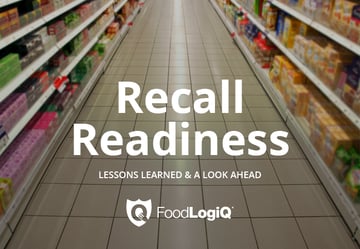After retailers pulled romaine lettuce off shelves in the Fall of 2018, consumers were left wondering if leafy greens were safe to eat.
Nothing alarms consumers at the grocery store more than seeing row after row of empty shelves where produce used to be. This was the scene during the nation’s largest recall of romaine lettuce one year ago. Although consumers were repeatedly reassured by the FDA earlier this year that all the affected produce was removed from retail locations, some consumers still have underlying concerns about whether the lettuce is really safe to eat.
The scope of the romaine lettuce recall
The romaine lettuce outbreak was traced back to Shiga Toxin-producing Escherichia coli (STEC) and Salmonella spp. which authorities linked to the E.coli O157:H7 multi-state outbreak. The outbreak occurred between March and June 2018, impacting 210 people in 36 states, according to the Food and Drug Administration (FDA).
The Centers for Disease Control and Prevention (CDC) and the FDA released a document on November 1, 2018, which outlined the factors that led to the contamination of romaine lettuce. Epidemiological data from people who had consumed romaine lettuce and became ill allowed the researchers to trace the produce back to the Yuma, Arizona growing region.
According to the FDA’s environmental assessment, the factors that contributed to the outbreak of E.coli O157:H7 in the Yuma growing region were:
- E.coli O157:H7 was found in an irrigation canal at three different locations in Yuma County
- The irrigation canal is likely the source of contamination of the romaine lettuce
- The FDA states that other sources of contamination may also have existed
- How and when the irrigation canal became contaminated is unknown
Leafy greens have a short shelf life, making them extremely challenging to trace back during an outbreak. Due to a complicated supply chain of growers, suppliers, distributors and retailers, the FDA escalated the situation and conducted further investigations into the Yuma agricultural region to determine where the pathogens originated - right down to the farm level.
Tracing back through a complex supply chain
Most of the romaine grown for consumption in the United States is produced in the Yuma, Arizona, agricultural region from November to March, which includes farms in Imperial County, California, and Yuma County, Arizona. In the wake of the 2018 recalls, the FDA sampled romaine lettuce in that region. Through trace-back analysis, researchers identified 36 fields of romaine lettuce on 23 farms that supplied the product eaten by people who became ill after consumption.
The FDA’s sampling program began December 17, 2018, to monitor the risk and prevent contaminated romaine lettuce entering the marketplace. Samples were collected at 26 different commercial coolers and cold storage facilities in Yuma in partnership with the Arizona Department of Agriculture and the Arizona Department of Health Services. Samples numbered 118 for each pathogen during the project.
Sampling romaine lettuce in centralized locations at the commercial facilities allowed the FDA to test multiple farms from one location. Each sample was identified and traced back to where it originated. No pathogens were detected in the 118 samples tested for STEC and Salmonella spp. The FDA concluded that the outbreak was not widespread in Yuma’s agricultural region.
What’s next from the FDA?
After the investigation of the E. coli outbreak was complete, then-FDA commissioner Scott Gottlieb said the FDA’s traceability efforts had been hampered by paper records, some of them handwritten. On April 30, 2019, the organization made an announcement that it was launching its New Era of Smarter Food Safety. The campaign focuses on traceability, digital technology and evolving food business models.
“The use of new and evolving digital technologies may play a pivotal role in tracing the origin of a contaminated food to its source in minutes, or even seconds, instead of days or weeks, when contamination does occur,” says the FDA’s statement.
The FDA has scheduled a public meeting on October 21, 2019, to discuss its New Era of Smarter Food Safety campaign. The all-day meeting will be held at the Hilton Washington, D.C./Rockville Hotel & Executive Meeting Center in Rockville, Maryland. Details of the meeting will be announced in September, according to an FDA notice.
Supply chain visibility for all stakeholders
The FDA’s Produce Safety Rule, which went into effect January 26, 2016, was designed to help prevent outbreaks in perishable products such as leafy greens. The rule is part of the agency’s ongoing efforts to implement the Food Safety Modernization Act (FSMA). Congress enacted FSMA in response to dramatic changes in the global food system by shifting the focus from simply responding to foodborne illness, to proactively preventing it. However, more needs to be done on an industry level to help protect consumers, according to Gottlieb’s statement back in November 2018:
“We strongly encourage the leafy greens industry to adopt traceability best practices and state-of-the-art technologies to help assure quick and easy access to key data elements from farm to fork.”
Supplier management and whole chain traceability are key for managing food safety risks and preventing widespread outbreaks. Technology can provide supply chain transparency for stakeholders, enabling them to quickly respond during a food safety event. FoodLogiQ’s Connect platform makes it possible for food companies to manage and access their data in a centralized location, offering clear supply chain visibility. For businesses looking to significantly reduce the risk of a recall while producing safe, nutritious food, the integrated supply chain management capabilities of FoodLogiQ is the perfect solution.
To learn more, request a demo.
Other posts you might be interested in
View All Posts
Food Industry
4 min read
| March 13, 2019
Recall Readiness: Lessons Learned & A Look Ahead
Read More
Supplier Compliance
8 min read
| May 31, 2018
In Wake of Romaine Lettuce Recall, FoodLogiQ Shares Thoughts on the Importance of Supply Chain Management and Food Traceability
Read More
Supplier Compliance
7 min read
| November 26, 2019

